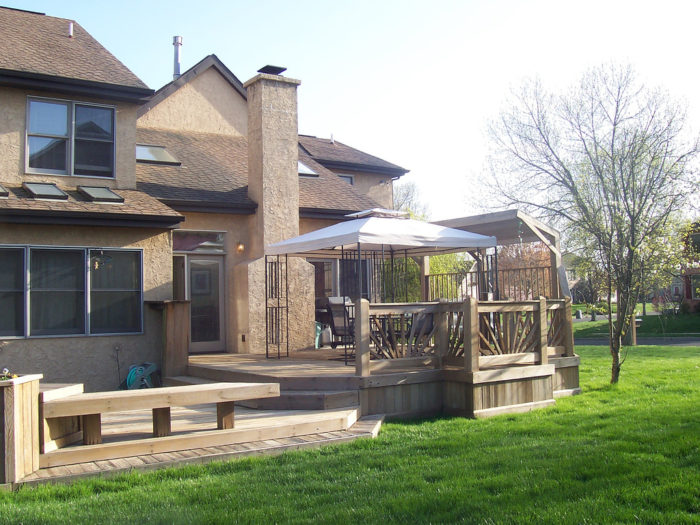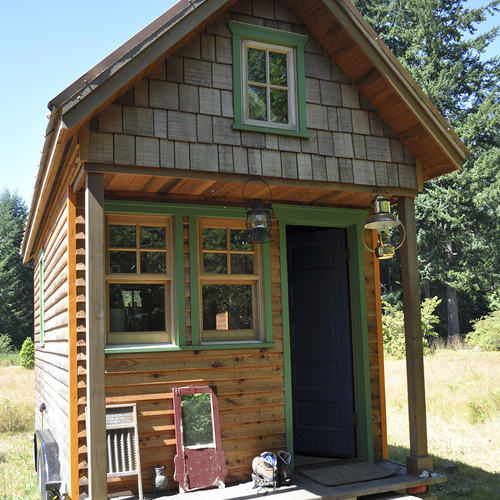
Image Credit: Ryan Consbruck via Flickr
A combination of bigger houses and shrinking building lots means that today’s single-family houses take up a greater percentage of their lots, leaving less room for the kids to play in their own backyards, but also reducing the amount of lawn maintenance homeowners need to perform.
An analysis by Trulia, an online real estate marketing company, found that on average, houses built since 2015 take up 25% of the lots on which they are built, compared to 13.9% in 1975. That’s due to building lots that are about one-third smaller than they used to be, and house footprints that have grown by more than 15%.
When plotted over time, the numbers show a steady decline in the amount of outdoor room that American families have for backyard gardens and, these days, pickup soccer games. In the 1800s, lot sizes were an average of 48,352 square feet — just over an acre — with the average house footprint at 1,668 square feet. A century later, Trulia reports, lot size had fallen to 7,200 square feet with the footprint dropping to 1,390 square feet. After that, footprints began to grow, reaching an average of 1,715 square feet by the 1970s and 2,077 square feet by the 2010s. Lot sizes dropped from 10,545 square feet in the 1970s to 9,148 square feet in the 2010s.
“This dramatic fall in lot sizes, paired up with a more modest decrease in the size of houses’ footprints resulted in a steady increase in lot usage from less than 4% to more than 21.5%,” Trulia said.
Many factors have contributed to the changing relationship between house size and lot size: the post-World War II economic boom, the rise of the automobile and growth of the suburbs, and the development of the interstate highway system, which allowed people to live much farther away from their jobs than they had in the past.
Regional differences are many
Older urban areas — including San Francisco, Philadelphia, Chicago, and Detroit — typically have very tight lots because many of their single-family houses were built in the late 19th and early 20 centuries when smaller lots were the norm. Cities like Las Vegas and Phoenix are much newer but also have tight lots because much of the housing stock was built after 1996.
But there are some urban areas where larger lots are common. In four Connecticut metro areas, for example, houses take up less than 10% of their lots on average, even when looking only at houses built after 2014. New England generally showed the smallest lot use in the country, with Providence, Rhode Island; Cambridge and Boston, Massachusetts; and Albany, New York, all with new houses covering less than 10% of total lot area.
“So, if your ideal home comes with visions of backyard barbeques, a place for the dog to run, and maybe even a pool and hot tub to host people on those warm summer nights, know that where you live will greatly impact how easy that will be to come by,” the Trulia report said. “On top of that, be wary of brand new construction which will likely not offer all the outdoor bells and whistles you may be dreaming of. Instead, keep an eye out for homes built during the post-war years up until the ’80s, or, better yet, in the early to mid-1800s.”
Separately, the National Association of Home Builders said in an Eye on Housing report that nearly 60% of all new homes started in 2016 were built within a community or a homeowners’ association.
That number has been climbing steadily since 2009, when about 48% of new homes were built in communities, as opposed to single building lots not located within any particular homeowner association jurisdiction.
Percentages ranged from a low of 29.5% in New England to 82.3% in the intermountain region stretching from Montana southward to New Mexico and Arizona.
Weekly Newsletter
Get building science and energy efficiency advice, plus special offers, in your inbox.














7 Comments
Why small lots?
I always wondered..
Why does so much of the housing in USA and AUS come on such tiny plots?
Especially Australia, where I was now. They have so much room that it's mind-boggling, yet they often have no yards AT ALL in many of the developments I saw.
Why is that?
Response to Davor Radman
Davor,
There are two reasons:
1. Buying land is a major expense for developers. The smaller the lot, the greater the profit for the developer.
2. A house with a small lot usually costs less than a house with a big lot, and home buyers care about low prices.
@Davor. It's complicated.
Municipalities looking to encourage affordable housing and expand their tax base allow developers to build on smaller lots. Larger more numerous homes = more tax revenue.
Income tax structure in the US encourages large homes (builder subsidy some would say).
Infill construction is generally overpriced because it many cases the developer demolishes a habitable house in order to build a large "luxury" single family dwelling. This is done in order to make the financing work (ie. most of the value of the property is in the new house and not the land which now has the embedded cost of a once habitable but now demolished house).
The article mentions some areas in CT where homes are on large lots. They didn't mention the area but I guarantee it's in Greenwich where they have multi-million dollar homes on 1/2 acre or larger lots.
Lastly, Americans still prize the detached single family dwelling (SFD) in lieu of a townhome or condominium. In the US ones own home is the typically the largest store of wealth and historically the detached SFD appreciates/holds its value vs. other forms of housing.
I understand that it's the
I understand that it's the land price.
But what I am curious about is why is the land expensive in the first place?
I mean, I was driving through miles of empty land, then a patch of tightly build houses, then again miles upon miles of empty land..
I understand that not all land is allowed to build upon, but why is that?
I don't mean HUGE lots. I mean 5000-10000 sqft. That's enough for a couple of trees, a tiny orchard, bbq place and a small garden. Where I live, we are often actually not even allowed to build if the plot is smaller than 5000sqft.
Its not just the land that is
Its not just the land that is expensive bigger lots means more expensive infrastructure and fewer homes to spread the cost over.....roads need to be longer to reach those bigger lots that a spread farther apart....sewers needs to be longer.....water supply....electric supply....storm drains longer
bigger lots means more $ upfront before you build a single house and fewer houses to spread that cost to.
I have a one acre lot with a backyard big enough for a regulation football game...house footprint is 2500 sq ft when you include the garage and the house is over 3000 sq ft not counting the 2000 sq ft basement.
@Davor
Many times its simply the fact that the land owners are looking to preserve their price/acre so they dribble out parcels for sale or the developer doesn't want to get over extended.
Also, it's more convenient.
Also, it's more convenient. If you want to complain to the neighbor about their noisy dog/kids, you just reach out the window and bang on their window.
Log in or create an account to post a comment.
Sign up Log in